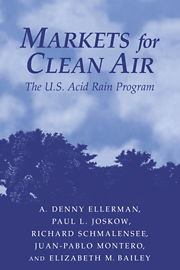Book contents
- Frontmatter
- Contents
- List of Illustrations
- List of Tables
- Preface
- Acknowledgments
- Part I Background
- 1 A Market-Based Experiment
- 2 A Political History of Federal Acid Rain Legislation
- 3 The Political Economy of Allowance Allocations
- 4 The Pre-1995 Trend in SO2 Emissions
- Part II Compliance and Trading
- Part III Questions and Implications
- Appendix: Effect of Title IV on SO2 Emissions and Heat Input by Susanne M. Schennach
- Bibliography
- Index
2 - A Political History of Federal Acid Rain Legislation
Published online by Cambridge University Press: 10 December 2009
- Frontmatter
- Contents
- List of Illustrations
- List of Tables
- Preface
- Acknowledgments
- Part I Background
- 1 A Market-Based Experiment
- 2 A Political History of Federal Acid Rain Legislation
- 3 The Political Economy of Allowance Allocations
- 4 The Pre-1995 Trend in SO2 Emissions
- Part II Compliance and Trading
- Part III Questions and Implications
- Appendix: Effect of Title IV on SO2 Emissions and Heat Input by Susanne M. Schennach
- Bibliography
- Index
Summary
EARLY HISTORY OF FEDERAL REGULATION OF SO2 EMISSIONS
The 1970 Clean Air Act Amendments
The 1990 Acid Rain Program and the factors that influenced its structure cannot be understood in isolation from the earlier history of the federal government's efforts to limit SO2 emissions produced in conjunction with the generation of electricity. The 1970 Clean Air Act Amendments, the first significant U.S. federal air pollution legislation, led to the establishment of national maximum standards for ambient concentrations of SO2, as for those of carbon monoxide, nitrogen dioxide, particulates, ozone, and lead. The states were largely responsible for meeting these standards in each local area. Each state was required to develop and have approved by EPA a state implementation plan (SIP) specifying actions to be taken to bring the state into compliance with the standards before the deadlines specified in the statute. The motivation for controlling SO2 emissions at this time was not concern about damage caused by acid rain. Rather, it rested on concerns about the effects of ambient SO2 concentrations on human health (for which “primary standards” were specified in the statute) and on other aspects of human welfare such as visibility (for which “secondary standards” were specified in the statute).
The 1970 Amendments also imposed New Source Performance Standards (NSPS) applicable only to SO2 emissions from new power plants. According to the NSPS, the emissions rate (ER) for new coal plants could not exceed 1.21b of sulfur dioxide per million Btu of fuel burned (0.81b/mmBtu for oil).
- Type
- Chapter
- Information
- Markets for Clean AirThe U.S. Acid Rain Program, pp. 13 - 30Publisher: Cambridge University PressPrint publication year: 2000
- 1
- Cited by



